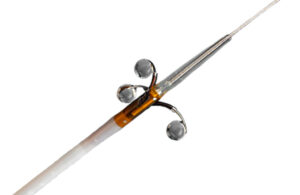
Ablative Solutions President and CEO Kate Rumrill [Photo courtesy of Ablative Solutions]
Ablative Solutions is developing the Peregrine renal denervation (RDN) system to treat hypertension. The company hopes to follow Recor Medical and Medtronic in winning FDA approval for the system.
“As a small company, it’s definitely better to be a fast follower than it is to be first to market,” Ablative Solutions CEO Kate Rumrill said in an interview. “I’m excited for Medtronic and Recor and their first year of sales and having these larger companies out there, doing some of that early work as far as market awareness and market adoption.”
Medtronic’s Symplicity Spyral RDN system uses radiofrequency (RF) energy, while Recor’s Paradise system uses ultrasound. Peregrine doesn’t deliver energy at all, instead using alcohol as a neurolytic agent.
“There really isn’t anything special about the alcohol per se, in the sense that alcohol has been used to ablate nerves for decades in the periphery [as] nerve blocking agents,” Rumrill said.
What’s special about Ablative Solution’s system is the proprietary Peregrine catheter system, designed to access the perivascular area around the renal arteries.
“Through that technology, we’re able to simply and in a reproducible way deliver that alcohol to the target site,” she said.
The system is named after the peregrine falcon — the world’s fastest animal — and the similarity between the raptor’s razor-sharp talons and the infusion catheter’s microneedles.
The Ablative Solutions Peregrine system’s design

The Ablative Solutions Peregrine infusion catheter delivers alcohol through three microneedles, pictured here with a drop of alcohol on each and guide tubes deployed. [Photo courtesy of Ablative Solutions]
The Peregrine system’s three nitinol microneedles deliver the alcohol when the single-use catheter is placed inside a patient’s renal artery.
Each microneedle has its own guide tube that deploys inside the artery, with all three pushing against the vessel wall to center the catheter within the vessel. Then the needles deploy for a clean shot through the vessel wall into the perivascular space, each delivering alcohol at precisely the desired depth for a total dose of 0.6 mL.
“We can treat vessels 3 to 7 mm in diameter,” Rumrill said. “Regardless of the size of the vessel, what these guide tubes do is ensure that you have contact with the inner lumen of the vessel wall. … It takes some of the guesswork out for the physician.”
The microneedles and guide tubes are radiopaque for fluoroscopic visibility to show the doctor the exact location of the catheter and guide tubes before deploying the microneedles. After delivering the alcohol, the physician retracts the needles and guide tubes back into the catheter, flushing with saline to ensure patency. Then it’s on to the patient’s other renal artery.
Alcohol RDN advantages
While it’s not yet clear whether alcohol RDN is safer or more effective than RF or ultrasound RDN, one advantage is system simplicity and cost. Because there’s no energy to be applied, an alcohol RDN system doesn’t need a generator.
“There’s no capital equipment costs, just a single-use catheter and a vial of alcohol,” Rumrill said. “For hospital system adoption, that capital equipment piece is taken off the table, which can help them immensely.”
The other advantage of Peregrine RDN is that it typically only requires one infusion per artery, though physicians can administer up to four infusions per patient if they wish to also denervate smaller, accessory arteries. Not all patients have accessory arteries, which come off the aorta either above or below the main artery. If those arteries are meaningful, treating them can lead to better patient outcomes.
“If it perfuses more than 20 percent of the blood flow to the kidney, we consider it meaningful,” Rumrill said. “In other words, if there’s more than 20 percent of the blood flow going to the kidney, likely there’s 20 percent of the nerves going to the kidney as well, so we choose to ablate those vessels.”
Less than a quarter of Peregrine patients have accessory arteries that call for additional infusions, Rumrill said, which means the average infusion per patient is around two. For comparison, some patients in Medtronic’s Symplicity Spyral RDN trials received dozens of ablations, while Recor’s Paradise system delivers four to six sonications per patient.
Ablative Solutions is betting that the Peregrine system can get the job done faster and with less complexity than the competition.
“With shorter procedure time, you have less contrast used, less fluoro time, radiation — all of those things that are important to not only the patient, but everybody in the cath lab,” Rumrill said.
Peregrine’s path to approval
Unlike the RDN systems from Recor and Medtronic, Ablative Solutions’ Peregrine is regulated by the FDA as a combination product, which means they’re dealing with the FDA’s Center for Devices and Radiological Health as well as the agency’s Center for Drug Evaluation and Research.
The Peregrine catheter already has FDA 510(k) clearances for infusing diagnostic and therapeutic agents into the perivascular area of the peripheral vasculature. Ablative Solutions hopes to win FDA new drug application (NDA) approval for treating hypertension with alcohol RDN.
NDA approvals typically take 12 months, so Ablative Solutions is planning for approval and product launch in 2025.
The company reported in December that its pivotal trial hit its primary endpoint, finding a statistically significant difference in 24-hour ambulatory blood pressure between treatment and sham procedure at three months. Ablative Solutions will unblind the study at six months to allow patients in the sham group to receive the actual procedure. The trial will follow patients for a total of three years.
Wakefield, Massachusetts-based Ablative Solutions plans to explore other applications of alcohol RDN, but because it’s a small company — it has fewer than 50 employees — for now it’s focused on the first indication of hypertension.
“We outsource a lot, and we have some really great consultants that are a great part of the team as well,” Rumrill said.
Ablative Solutions is outsourcing manufacturing of the medical-grade alcohol used in its system to maintain some control over the quality and supply. She declined to name the partner, but offered some advice for device developers looking to partner with contract manufacturers.
“Start early and do your homework,” she said. “Regardless of who you select, in general whenever you’re working with a third-party supplier, make sure you have somebody in-house that has that expertise so they can interact and manage that relationship. For everything from clinical trial outsourcing to device manufacturing, every step of the way you still need to have somebody with that expertise internally to know are you on track and to be able to ask those questions of the supplier.”
More from Medical Design & Outsourcing: The best medtech innovations of 2023